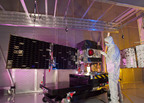Ball Aerospace Ships STPSat-2 to Kodiak Launch Complex
BOULDER, Colo., Aug. 2 /PRNewswire-FirstCall/ -- Ball Aerospace & Technologies Corp. has shipped the STPSat-2 satellite built for the U.S. Air Force Space and Missile Systems Center, Space Development and Test Wing (SDTW) to Alaska's Kodiak Launch Complex for scheduled liftoff aboard a Minotaur 4 rocket for a fall 2010 launch.
(Photo: https://photos.prnewswire.com/prnh/20100802/LA43922)
(Photo: http://www.newscom.com/cgi-bin/prnh/20100802/LA43922)
STPSat-2 is the first spacecraft for the Department of Defense (DoD) Space Test Program Standard Interface Vehicle (STP-SIV) program managed by Space Development and Test Wing at Kirtland Air Force Base, Albuquerque, N.M. The STP-SIV architecture developed for STPSat-2 supports the Operationally Responsive Space strategy to ensure U.S. space superiority.
The STPSat-2 spacecraft provides a standard interface compatible for multiple launch vehicles that support a variety of experimental and risk reduction payloads at different low-Earth orbits. This was demonstrated on STPSat-2 when a third payload was manifested following the Critical Design Review and then successfully integrated without spacecraft design modification. Using flight-proven hardware for the spacecraft (and developmental hardware only on the experimental payloads), each bus can accommodate up to four independent payloads, each one having its own separate power and data interface.
"STPSat-2 is putting responsive space into practice for the U.S. Air Force," said David L. Taylor, president and CEO of Ball Aerospace. "This small but robust satellite provides a flexible solution for a variety of customer mission needs, from missile warning, to earth-remote sensing, to situational awareness."
Production is also continuing at Ball on the second STP-SIV, STPSat-3, an identical spacecraft that will host four DoD experimental payloads. The STPSat-3 spacecraft will be completed in November, with payloads integrated in the first quarter of 2011.
In addition to STPSat-2, the Minotaur 4 rocket will launch two FASTRAC spacecraft from the University of Texas, the Air Force Academy's FalconSat 5 satellite, NASA's O/OREOS CubeSat mission, and NASA's FASTSAT (Fast, Affordable, Science and Technology Satellite), which includes the Threat Detection System built by Ball Aerospace for the Air Force Research Lab/Space-Based Advanced Sensing & Protection Branch for detecting tracking, and characterizing space objects and the space environment.
Ball Aerospace & Technologies Corp. supports critical missions of important national agencies such as the Department of Defense, NASA, NOAA and other U.S. government and commercial entities. The company develops and manufactures spacecraft, advanced instruments and sensors, components, data exploitation systems and RF solutions for strategic, tactical and scientific applications. For more information visit www.ballaerospace.com.
Ball Corporation (NYSE: BLL) is a supplier of high-quality metal and plastic packaging for beverage, food and household products customers, and of aerospace and other technologies and services, primarily for the U.S. government. Ball Corporation and its subsidiaries employ more than 14,000 people worldwide and reported 2009 sales of more than $7.3 billion.
Forward-Looking Statements
This release contains "forward-looking" statements concerning future events and financial performance. Words such as "expects," "anticipates," "estimates" and similar expressions are intended to identify forward-looking statements. Such statements are subject to risks and uncertainties which could cause actual results to differ materially from those expressed or implied. The company undertakes no obligation to publicly update or revise any forward-looking statements, whether as a result of new information, future events or otherwise. Key risks and uncertainties are summarized in filings with the Securities and Exchange Commission, including Exhibit 99.2 in our Form 10-K, which are available at our Web site and at www.sec.gov. Factors that might affect our packaging segments include fluctuation in product demand and preferences; availability and cost of raw materials; competitive packaging availability, pricing and substitution; changes in climate and weather; crop yields; competitive activity; failure to achieve anticipated productivity improvements or production cost reductions; mandatory deposit or other restrictive packaging laws; changes in major customer or supplier contracts or loss of a major customer or supplier; and changes in foreign exchange rates or tax rates. Factors that might affect our aerospace segment include: funding, authorization, availability and returns of government and commercial contracts; and delays, extensions and technical uncertainties affecting segment contracts. Factors that might affect the company as a whole include those listed plus: accounting changes; changes in senior management; the current global recession and its effects on liquidity, credit risk, asset values and the economy; successful or unsuccessful acquisitions, joint ventures or divestitures; integration of recently acquired businesses; regulatory action or laws including tax, environmental, health and workplace safety, including in respect of climate change, or chemicals or substances used in raw materials or in the manufacturing process; governmental investigations; technological developments and innovations; goodwill impairment; antitrust, patent and other litigation; strikes; labor cost changes; rates of return projected and earned on assets of the company's defined benefit retirement plans; pension changes; reduced cash flow; interest rates affecting our debt; and changes to unaudited results due to statutory audits or other effects.



















